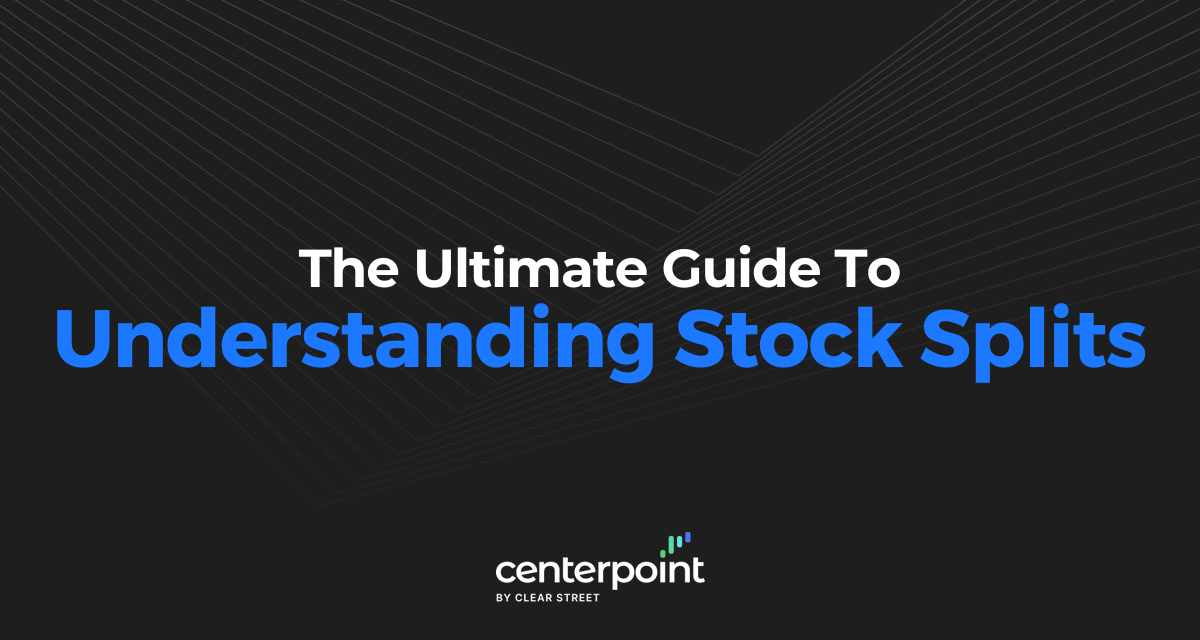Understanding a Stock’s Structure
Publicly listed companies are structured as business entities comprised of stock shares. Each share represents an ownership piece of company. The market capitalization value of a company is the sum of its outstanding shares multiplied by the current price of the stock.
It’s important to also understand the distinction between authorized shares and outstanding shares. Authorized shares are the maximum number of shares the company can issue as per its Articles of Incorporation. The outstanding shares are the total number of shares that have been created and issued.
With public stock, there are free trading shares and restricted shares. Restricted stock can not be traded or transferred until certain company and regulatory conditions are met. Restricted stock is often granted as a form of compensation in addition to salary and benefits. The stock’s float is calculated by subtracting restricted shares, treasury shares, insider and beneficial owner shares from outstanding shares. The float is the total number of free trading public shares can be bought and sold on the public trading exchanges.
The Pie
Think of company as a large pie with each slice being a share that represents ownership in the company. There are circumstances that may warrant the company create more pieces of the same three-pound pie by splitting the existing slices. A two-for-one stock split (2:1 split) would split each existing slice of pie in half. If you owned 100 shares of XYZ at $20-per share, you would now own 200 shares at $10-per share. In other words, your slice of pie didn’t get larger, you just own two pieces of the same piece equal to the weight of the single slice it was before.
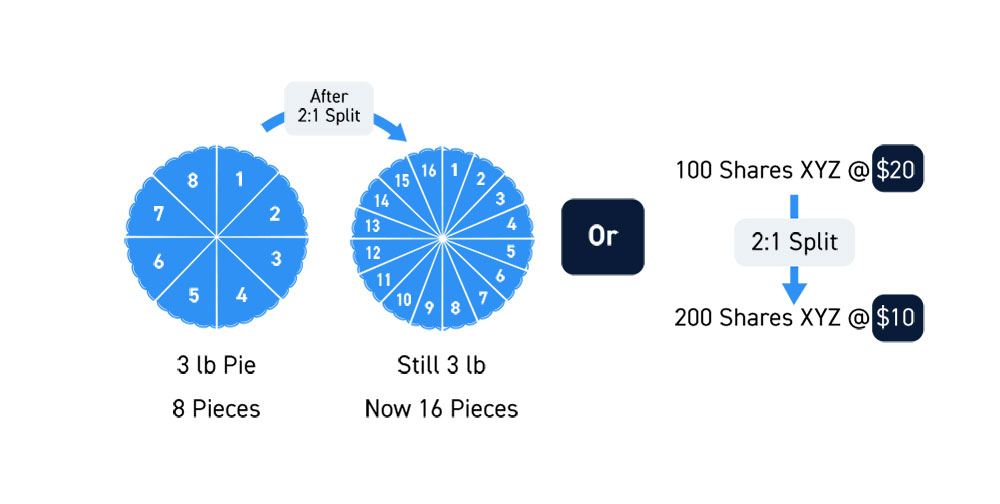
What is a Stock Split?
Stock splits are corporate actions that effectively divide existing shares into smaller pieces without affecting the market capitalization while increasing the outstanding shares and stock float. Stock splits are decided by a company’s board of directors and publicly announced as to the denomination of the split and the effective date upon regulatory approval.
If the net effect on valuation is neutral, you may be wondering what the purpose of a stock split is to begin with.
Why Would a Company Do a Stock Split?
By splitting stock, companies effectively prices shares at cheaper prices while boosting the supply by increasing the float. This provides liquidity, which usually draws more interest and investors into the mix.
Companies usually split their stock when prices become “too expensive”. As a stock price rises, investors tend to hold their shares thereby creating a liquidity vacuum. The thinner liquidity tends to propel share prices even higher often out of reach for retail investors and becoming more volatile. In order to expand the base of shareholders and minimize volatility while boosting liquidity, a company will split its shares.
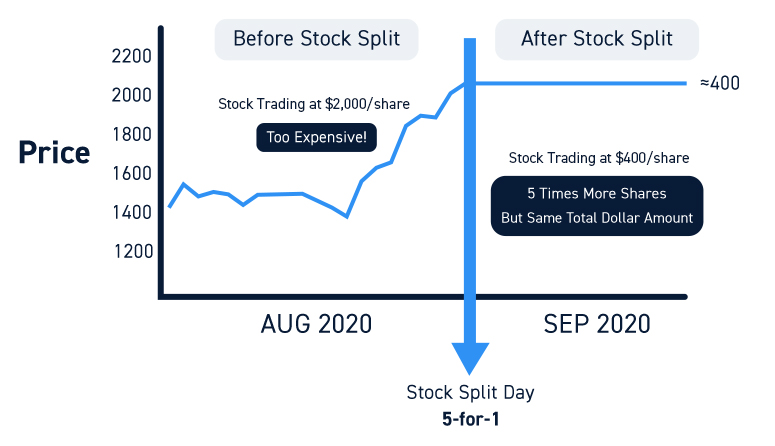
Stock splits are usually considered bullish since having stock that is “too expensive” is not a bad thing. It implies the underlying business is thriving. Additionally, when the stock price rises after the split, the profit gains compound quicker by owning twice the number of shares (post 2:1 stock split).
What is a Reverse Stock Split?
On the other side of the spectrum, a company may decide to issue a reverse split to minimize the outstanding shares, float and liquidity. This action basically merges existing shares. A five-for-one (5:1) reverse split would effectively convert your 1,000 shares of XYZ priced at $1 into 200 shares priced at $5-per share. The value and market capitalization is the same, just with less shares.
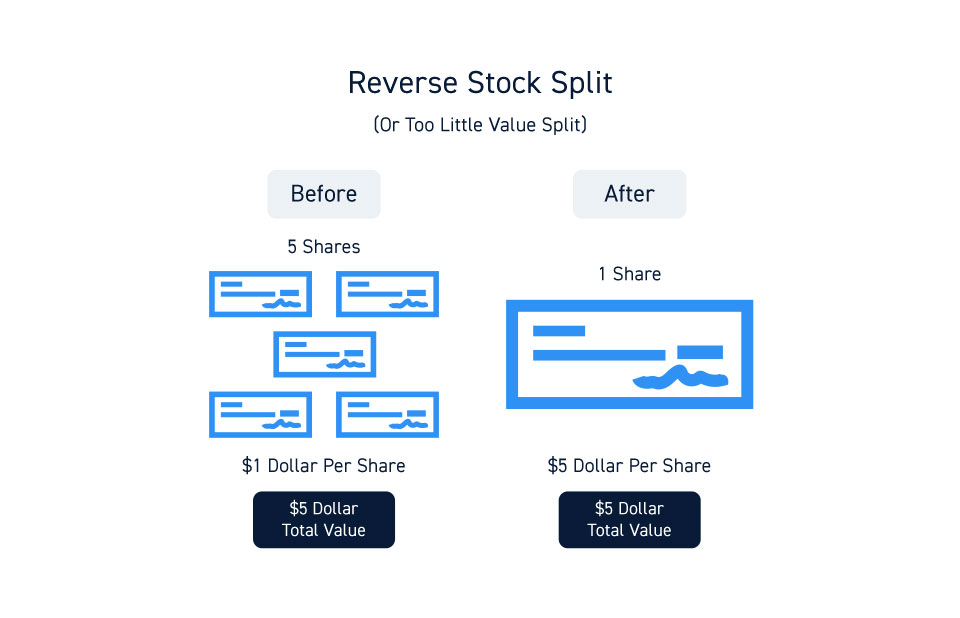
Why Would a Company Do a Stock Split?
A reverse split is usually issued by companies when their stock prices have fallen “too low” or below exchange minimum share price limits. Reverse splits imply poor underlying business performance evidenced by the low stock price. While the intent is to thin out the liquidity and improve the perception of the company with higher priced shares, reverse splits tend to be considered bearish in the long run. However, in the short-term, a reverse split can panic bears into covering their shorts due to the thinning float which can stifle stock borrows.

Why Do Leveraged ETFs Reverse Split?
Numerous investors and traders have been burned holding some popular 2X to 3X leveraged inverse/bearish ETFs assuming they can be held as a portfolio hedge longer term. Leveraged ETFs that involve synthetic long/short positions using futures contracts to “mirror the one-day performance” of an index is susceptible to reverse splits as the term structure exposes the ETF to decay from contango. VIX products are notorious for decaying 8-12% on a monthly basis which is why instruments like the UVXY tend to reverse split often. The USO ETF before an 8:1 reverse split as a result of May 2020 crude oil contracts going negative for the first time in history.
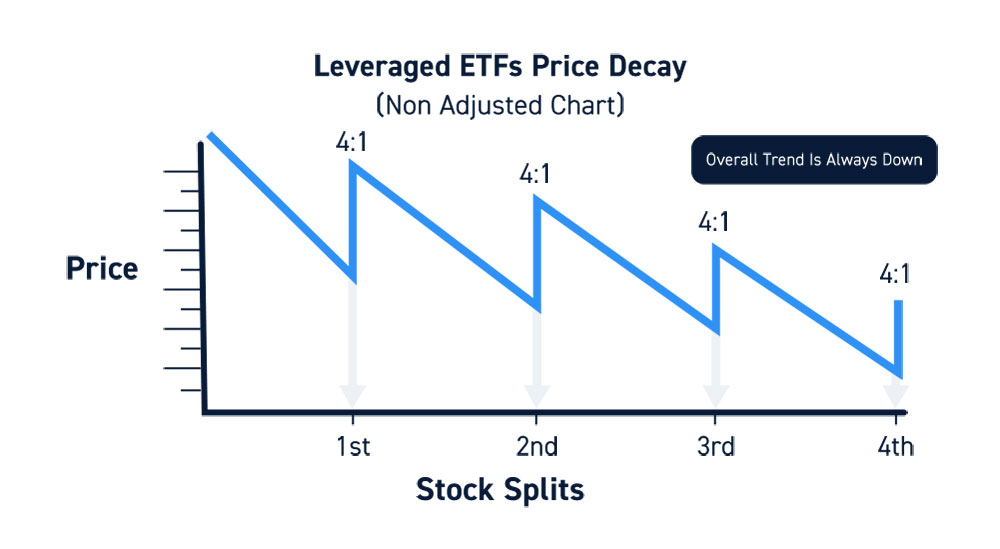
Why Traders Need to be Aware of Splits
The material impact that traders will notice on stock splits is the thicker liquidity. This results in tighter spreads but also slower price action and volatility. For some traders, this is a welcomed situation since it enables better pricing through scaling more shares at tighter spreads. Momentum traders may not like the adjustment to the smaller volatility and price range and move on to other stocks. Investors will appreciate the access to more liquidity and stability enabling longer-term holds.
Impact of Reverse Splits
On the flipside, reverse splits can increase volatility while thinning out liquidity. It can also turn the stock into hard-to-borrow (HTB) shares, which incur higher costs to implement shorts accompanied by higher risk of short squeezes. For leveraged inverse ETFs, reverse splits provide more volatility and larger price swings that seasoned traders are accustomed to.
Impact on Holdings
Just like the example at the beginning of this article, waking up one morning and seeing your shares cut in half with no impact on your account balance is a clue that your stock underwent a split. While your net value won’t change much, keep in mind that any price move is compounded by the multiple of the share split. For example, your 1,000 shares of XYZ at $20 is now 2,000 shares at $10. The $0.20 price swing you are accustomed to scalping has double the impact on with 2,000 shares. While the liquidity eventually causes trading volatility to slow down with smaller price swings, the initial action tends to be very volatile for a few days.
Impact on Options
If you own options on a stock that is undergoing a stock split, it can undergo a contract adjustment relative to the split. For example, a 2:1 stock split results in an automatic adjustment having twice the number of options contracts at half the strike price. The same applies inversely with reverse splits where the holder of the options will have the same number of contracts at a higher strike price. For odd number/lot splits like a 3:2 stock split, the stock price is reduced by 1.5, subsequently the options holder will have the same number of contracts at a reduced strike price (1.5). If you don’t want to deal with contract adjustments, it’s best to close the positions ahead of the split especially with calls. If you want to hold the position through split, then consider rolling the options early.

